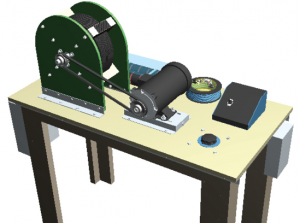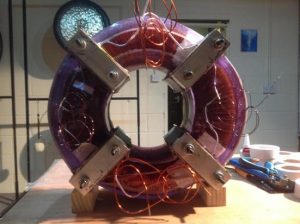
Announcing the 5th edition QEG Free Energy Generator Plans by authors James Robitaille and Tivon Rivers. Two and a half years of co-development has led to the open source (PATENT FREE!) development of this generator, and the 5th ed. plans include 4 secondary transformer designs, and instructions for converting volt-amperes reactive or VARs to watts using a bi-toroid transformer.
Our team builds generators and teaches others how to build because we are concerned for humankind and the planet, and WE ARE TIRED OF BEING RIPPED OFF by the big and powerful energy companies!

The Quantum Energy Generator, or QEG, is an adaptation of one of Nikola Tesla’s many patented electrical generator / dynamo / alternator designs scaled to produce electrical power in the range of 10‐15 kW (kilowatts) continuously, and can be set up to provide either 120 Volt or 230‐240 Volt single phase output.
The original intent of the patent is further expanded through subsequent utilization and application of mechanical self‐resonance and radiant energy, in order to make the machine self‐sustaining.
The QEG is not a complicated device, as it is designed to work in harmony with nature’s laws, rather than the power wasting closed‐system symmetric motor and generator designs used in today’s mainstream industry.

* Parts & Specs *
* Insulation Components *
* Suggested Tools & Equipment *
* Generator Assembly Steps *
* Mechanical & Electrical Setup *
* The Drive System *
* NEW!! Exciter Coil Design *
* Safety Interactions *
* Radiant Energy *
* Full Professional CAD Drawings Package*
As always, James presents clear instructions for basic construction from the bare steel to precise capacitor value to 1st resonance. For those in the know, 1st resonance, or parametric oscillation, is the stage where the light bulbs are lit using only the energy produced in the core.
James also presents advanced tuning procedures where you will learn how to align to the resonant frequency of the core steel (2nd resonance) and exciter coil tuning (3rd resonance). You’ll also have the new exciter coil design in the 5th edition QEG Build Manual. ($47 usd – see bonus course material below)

If you’re like we were and have searched for hours upon hours on the Internet for plans to build your own generator, and have gotten nothing but fragmented results, this manual is your final stop!
This is the most comprehensive and accurate information available on the subject of how to build your own energy efficient and potentially fuel-less generator because…
* We have already done the trial and error research
* We have already spent the $$$$ so you don’t have to (tens of thousands of dollars developing and building 6 prototypes)
* We are the absolute authority; you won’t find anything like this on the Internet *
Some history about the global development of the QEG (please watch video below):
The QEG Project is being implemented in a unique manner. Rather than completing all stages of development of this product privately, and then claiming ownership rights, this project is open sourced and teams of engineers around the world are allowed to participate in developing the device together. These engineers are a diverse group networked across many different countries.
Co-development requires persistence, follow through, discipline, humility, applied wisdom, an open mind and good consistent communication. These characteristics are what creates the strength needed to overcome any suppression. We have been building a foundation of knowledge, infrastructure, and strengthened communication that will be able to fully support the change that this applied technology will bring to our society.
MANUAL EXCERPTS:
“….Installing Mica Plates and Corner Insulation:
After you’ve cut 16 C-shaped mica plates, install them on the top and bottom of each pole piece
(front and back). We used a small amount of contact cement to hold them in place for the rest of
the processing (see photos), but they can also be taped in place with the reinforced Mylar tape.
Mica plates (and corner insulation pieces) are installed after core taping and before winding.
Make 16 pcs. of corner insulation from high voltage insulating paper (such as DuPont Nomex
type 418 or equivalent) at 0.015 to 0.025” thickness…”
“…Rotor Adjustment:
At this point the rotor position should be adjusted so that it spins freely inside the core without
rubbing. This is where you may need to adjust the bearing positions repeatedly until the rotor
spins freely. (The gap between the rotor and stator is .010” or less, making this step a little
delicate). However, once the rotor is tightened in position it does not tend to move. Place the 2-
½” pulley on the generator shaft at this time; it can be used to turn the rotor by hand while
adjusting its position…”
“…Public promotion and full transparency: we do not operate under secrecy or non-disclosure
agreements and all information about the device and our research has been publicly reported on
the internet. We have used the viral nature of the internet and social media to ensure that millions
of people know about the QEG and are following the progress of the project…”

Class 2 Video (86:34): Detailed discussion of parts needed for completion of QEG generator core; Presentation and description of core mechanical part drawings and specifications; Preliminary discussion of platform construction and options, with drawings; Explanation of power generation by means of parametric resonance; Answers to previously submitted email questions from class members.

Class 2 PDF (82 pages): Detailed documents and photos of parts needed for completion of Quantum Energy Generator (QEG) core.
STUDENT REVIEW: “The QEG101 Course is my ultimate companion reference guide manual. It is my QEG library where I can find all I can imagine from winding core direction diagrams to exciter coil techniques and even my own critical QEG redesign questions answered by James.”
QEG101 Student, Greece
“When constructed properly, these modes are capable of accumulating their own operating energy in addition to generating a surplus which can be used in electrical networks using voltage converters as required. Just imagine. You have a motor turning a larger output generator, and the generator is producing enough energy to keep the motor running, as well as enough left over to power other loads (called ‘Q-Mo-Gen’).”

If you’re an engineer, or even just someone who is interested in experimenting with electricity and motors, this manual makes these unique building concepts obtainable for the average engineering enthusiast. You don’t have to be a rocket scientist to build this generator. However, building can be very challenging and you’ll want to make sure you are fully equipped with as much information as possible. Instructions like the ones found in this manual are rare, hard to find, and usually missing important information needed for building.
Plus, the free bonus of our beginners build class sample will introduce you to a further series of video step by step instructions, should you desire a more personal learning experience.
…your purchase today puts you in a global arena of builder communities in as many as 50 countries! Here, knowledge and building progress is shared via forums, videos and social media.
Because QEG communities around the world are developing this potentially fuel-less generator simultaneously and sharing information, we CAN get free from energy tyranny. We are doing just that by building our own devices and creating our own energy!